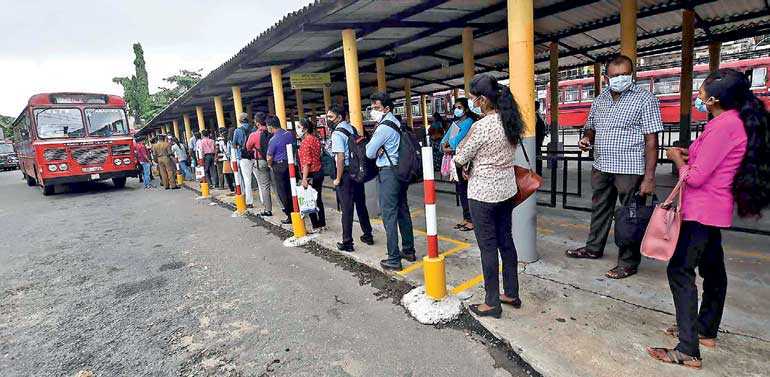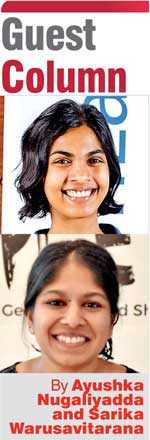Sunday Apr 20, 2025
Sunday Apr 20, 2025
Tuesday, 13 October 2020 00:53 - - {{hitsCtrl.values.hits}}

As we face a potential second wave with community spread, it is crucial that Sri Lanka looks back on the good practices instituted during the first – Pic by Shehan Gunasekara
Nearly 10 months on from the declaration of COVID-19 as a global pandemic, many countries eased restrictions, lockdowns and curfews in an attempt to stimulate their economies and commence the recovery process.
Among these countries, Sri Lanka has made notable strides in controlling the spread of the virus thus far. However, moving out of a lockdown is no guarantee that the outbreak is being kept at bay, even while borders remain closed to the extent that they currently are, as demonstrated by recent evidence of the emergence of a new cluster. Until a vaccine is made available, it is vital that Sri Lankans build on the existing progress made in order to keep all communities safe and healthy going forward.
Sri Lanka has so far benefitted from the payoffs of an early lockdown. The country partially lifted its island-wide lockdown in mid-May and completely removed it by the end of June. Since then, we have seen an easing of inter-district travel restrictions, the opening of schools, universities, places of worship, restaurants and bars with safety measures in place, and a relaxing of attitudes towards social distancing guidelines in general. International borders remain closed for the foreseeable future, save for scheduled repatriation flights.
Notably, General Elections were held in August 2020 with stringent and exemplary precautionary measures in place, which were widely praised as being safe and efficient, despite initial concerns about crowds at polling stations.
In the months following the election, events, concerts, weddings and other large gatherings have taken place with varying degrees of social distancing and COVID-19 precautions observed. While temperature checks and handwashing/sanitisation are still largely mandatory prior to entering public spaces, such guidelines were fast becoming simple cursory checks, with less enforcement as time went by with no reports of community spread in the country. This is especially true outside urban areas, where the use of masks and frequent sanitisation have not yet been normalised. In the wake of recent cluster outbreaks and the subsequent curfews issued in those police divisions, it is clear that these next few weeks could prove to be crucial for Sri Lanka’s overall COVID-19 trajectory and for the island to maintain or do better than its current recovery rate of 73.4% as at 8 October 2020 (a drop from a previous rate of 93.9% as at 5 October, owing to the recent outbreaks).1
While the rapid response in instituting a lockdown, establishing quarantine centres and contact tracing allowed for the containment of the virus during the previous lockdown period, taking a look at the feasibility of adopting and contextualising additional best practices from other successful countries could be useful in managing and/or preventing a second wave of the virus in Sri Lanka.
Taiwan, for instance, appears to have done very well in managing COVID-19 and avoiding further outbreaks. Its success is a result of a high degree of cooperation and collaboration across government and non-government entities in containing the virus, with quick, decisive decision-making and the use of technology to enable effective contact tracing and quarantine enforcement. Furthermore, it benefited from a high degree of public trust in government institutions and open and transparent communication with the public.2
On the other hand, New Zealand, Iceland and Vietnam serve as examples of countries that were internationally lauded for their largely successful containment strategies and still succumbed to cluster and community outbreaks in the months since reopening. Nevertheless, all three countries combated these outbreaks with strict restrictions and rigorous testing and monitoring,3 and have managed to bring their respective situations under control so as to allow for the easing of restrictions once again.4 A quick review of new strategies employed in some of these countries that Sri Lanka could potentially consider are seen in table 1.
As we face a potential second wave with community spread, it is crucial that Sri Lanka looks back on the good practices instituted during the first lockdown. Global experiences have demonstrated that short-term mitigation methods will not suffice, as evidenced by occasional outbreaks in even the most prepared countries thus far. Constant vigilance and adherence to precautionary measures, such as the wearing of face masks and continued restrictions on public gatherings, will need to be normalised and enforced. Moreover, these measures should also be enforced uniformly and stringently, so as to ensure mask-wearing and social distancing are in practice in all reaches of the country, and not just within Colombo.
Any containment and mitigation measures taken by the Government should be executed with ample transparency, so that communities are accepting of restrictions and to ensure that there is no room for misinformation that could potentially create panic. Unified communication is key to ensuring adherence to regulations. This requires information to be disseminated via a few selected, credible sources in all three languages; the Health Promotion Bureau, for instance, has developed a very user-friendly, trilingual website to disseminate COVID-related information.5
Moreover, to ensure truly inclusive communications, information should also be circulated via visual/video and auditory means to ensure that persons with disabilities are also able to access news, guidelines and regulations. It is also imperative that media outlets adhere to ethical reporting practices, actively protect the security and privacy of potential patients, and avoid the stigmatisation of patients at all costs, which will only be counterproductive by leading to a reduction in people reporting their medical conditions, seeking medical care or adhering to regulations.
It is clear that the economy can ill-afford a second extended lockdown – therefore, Sri Lanka must look back on the good practices instituted during the first lockdown and how we can execute them better. Ensuring business continuity will not only be vital to safeguard livelihoods going forward, but also in minimising the trade-off between prioritising economic and health safety, such that citizens will not have to make a choice between protecting their livelihoods and protecting themselves from COVID-19; this choice could potentially make a unified citizen-led response to the outbreak less effective, as citizens are more likely to de-prioritise COVID-19 etiquette.
Sri Lankan citizens and the Government demonstrated their unified commitment to public health and agility in adapting to new circumstances when the entire country transitioned almost overnight to working remotely during the first lockdown. This agility needs to be supported to ensure the continuity of business while adhering to COVID-19 regulations.
As some of us shift back towards remote and more flexible work arrangements, it is clear that we need improved infrastructure and even regulations to allow for a smooth transition and an eventual institutionalising of these practices in ways that would ensure no further disruption (to the extent possible) to education and economic activity. This could include for instance, amendments to existing legislation on work hours and remuneration practices, and the acknowledgement of unpaid care-work in combination with improved systems for childcare.
Sri Lanka still has the potential to capitalise on what is referred to as the ‘COVID Dividend’ and ensure the country’s resilience to a pandemic and any other future shocks. The present resurgence of cases necessitates Sri Lanka taking the opportunity to explore, test and implement long-term solutions that will not only safeguard citizens’ health, but also create avenues for the country to regain its development trajectory.

(Ayushka Nugaliyadda is the Economist and Systems Design Lead and Sarika Warusavitarana the Sociologist and Solutions Mapping Lead of Citra Social Innovation Lab. Together with the Citra team, they have previously written related pieces on the impact of COVID-19 on Sri Lanka’s economy, environment, society and governance, and conducted a comparative analysis of global responses to COVID-19 accessible at www.citralab.lk. Citra Lab is a joint initiative of the State Ministry of Skills Development, Vocational Education, Research & Innovation and UNDP in Sri Lanka.)
Footnotes
1 Health Promotion Bureau website (8 October 2020). Retrieved from: https://hpb.health.gov.lk/covid19-dashboard/.
1 The Conversation (29 June 2020). “What coronavirus success of Taiwan and Iceland has in common.” Retrieved from: https://theconversation.com/what-coronavirus-success-of-taiwan-and-iceland-has-in-common-140455
1 Axios (5 October 2020). “New Zealand “beat the virus again,” PM Jacinda Ardern says.” Retrieved from: https://www.axios.com/-9290fb75-dff5-43d2-8f9a-3203813e5a29.html.
1Times of India (26 September 2020). “Proficient handling of the second wave of Coronavirus by Vietnam: underlines the salience of aggressive testing and precautionary measures by citizens.” Retrieved from: https://timesofindia.indiatimes.com/blogs/ChanakyaCode/proficient-handling-of-the-second-wave-of-coronavirus-by-vietnam-underlines-the-salience-of-aggressive-testing-and-precautionary-measures-by-citizens/.
1 Health Promotion Bureau website (8 October 2020). Retrieved from: https://hpb.health.gov.lk/covid19-dashboard/.
Discover Kapruka, the leading online shopping platform in Sri Lanka, where you can conveniently send Gifts and Flowers to your loved ones for any event including Valentine ’s Day. Explore a wide range of popular Shopping Categories on Kapruka, including Toys, Groceries, Electronics, Birthday Cakes, Fruits, Chocolates, Flower Bouquets, Clothing, Watches, Lingerie, Gift Sets and Jewellery. Also if you’re interested in selling with Kapruka, Partner Central by Kapruka is the best solution to start with. Moreover, through Kapruka Global Shop, you can also enjoy the convenience of purchasing products from renowned platforms like Amazon and eBay and have them delivered to Sri Lanka.
Discover Kapruka, the leading online shopping platform in Sri Lanka, where you can conveniently send Gifts and Flowers to your loved ones for any event including Valentine ’s Day. Explore a wide range of popular Shopping Categories on Kapruka, including Toys, Groceries, Electronics, Birthday Cakes, Fruits, Chocolates, Flower Bouquets, Clothing, Watches, Lingerie, Gift Sets and Jewellery. Also if you’re interested in selling with Kapruka, Partner Central by Kapruka is the best solution to start with. Moreover, through Kapruka Global Shop, you can also enjoy the convenience of purchasing products from renowned platforms like Amazon and eBay and have them delivered to Sri Lanka.